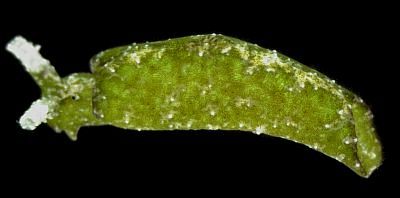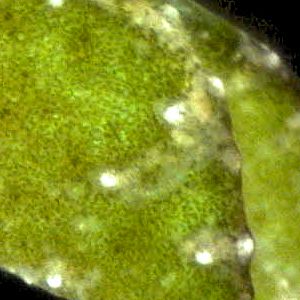Elysia tuca from west coast of Florida
April 28, 2001
From: Anna L. Bass

Hey,
Thought you might could use this photo of Elysia tuca. The animal was collected on Halimeda monile. I'm not sure of the water depth, but it was in a sea grass bed. Probably not deeper than 2m. The individual is 10mm in length.
Regards,
Anna
abass@helios.acomp.usf.edu
Bass, A.L., 2001 (Apr 28) Elysia tuca from west coast of Florida. [Message in] Sea Slug Forum. Australian Museum, Sydney. Available from http://www.seaslugforum.net/find/4240
Thanks Anna,
I have included alongside an enlarged view of your photo to show part of the parapodia and the intricate network of branching digestive gland ducts in which the choroplasts from its algal food are stored. To those of you unfamilar with these animals, E. tuca is one of the solar powered sacoglossans which keeps the chloroplasts from its algal food alive in its body and uses the sugars and other nutrients produced by photosynthesis for it own use.
Waugh, GR; Clark, KB (1986): Seasonal and geographic variation in chlorophyll level of Elysia tuca (Ascoglossa: Opisthobranchia). Marine Biology, 92: 483-487.
Thanks again Anna for a photo of another relatively common animal which is quite unknown to most of us.
Best wishes,
Bill Rudman
Related messages
-
Elysia tuca from Bermuda
From: Kimberly Holzer, September 7, 2007 -
Elysia tuca from the Bahamas
From: Anne DuPont, September 12, 2005 -
Elysia tuca with parasite
From: Marina Poddubetskaia, February 21, 2004 -
Elysia tuca from Southern Bahamas
From: Marina Poddubetskaia, February 20, 2004 -
Chemoreception in Elysia tuca
From: Charlie Hileman, June 17, 1999
